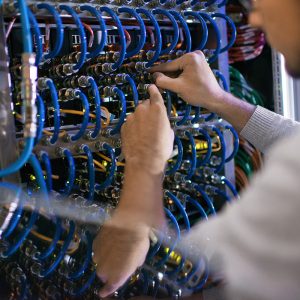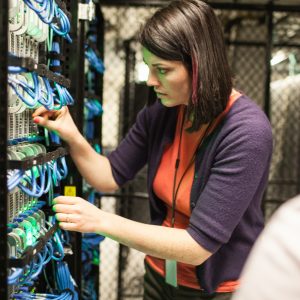Descripción del curso:
This course features intensive hands-on training that focuses on installing, configuring, and managing VMware
vSphere® 7, which includes VMware ESXi™ 7 and VMware vCenter Server® 7. This course prepares you to administer a
vSphere infrastructure for an organization of any size.
This course is the foundation for most of the other VMware technologies in the software-defined data center.
Objetivos del Curso
By the end of the course, you should be able to meet the following objectives:
• Describe the software-defined data center (SDDC)
• Explain the vSphere components and their function in the infrastructure
• Install and configure ESXi hosts
• Deploy and configure VMware vCenter® Server Appliance™
• Use VMware vSphere® Client™ to manage the vCenter Server inventory and the vCenter Server configuration
• Manage, monitor, back up, and protect vCenter Server Appliance
• Create virtual networks with vSphere standard switches
• Describe the storage technologies supported by vSphere
• Configure virtual storage using iSCSI and NFS storage
• Create and manage VMware vSphere® VMFS datastores
• Use the vSphere Client to create virtual machines, templates, clones, and snapshots
• Create a content library and deploy virtual machines from templates in the library
• Manage virtual machine resource use
• Migrate virtual machines with VMware vSphere® vMotion® and VMware vSphere® Storage vMotion®
• Create and manage a vSphere cluster that is enabled with VMware vSphere® High Availability and VMware vSphere®
Distributed Resource Scheduler™
• Discuss solutions for managing the vSphere life cycle
• Use VMware vSphere® Lifecycle Manager™ to perform upgrades to ESXi hosts and virtual machines
Módulos del curso
1 Course Introduction
• Introductions and course logistics
• Course objectives
2 Introduction to vSphere and the Software-Defined
Data Center
• Explain basic virtualization concepts
• Describe how vSphere fits into the software-defined
data center and the cloud infrastructure
• Explain how vSphere interacts with CPUs, memory,
networks, and storage
• Recognize the user interfaces for accessing the
vCenter Server system and ESXi hosts
• Describe the ESXi host architecture
• Navigate the Direct Console User Interface (DCUI)
to configure an ESXi host
• Recognize ESXi host user account best practices
• Install an ESXi host
• Use VMware Host Client™ to configure ESXi host
settings
3 Virtual Machines
• Create and provision a virtual machine
• Explain the importance of VMware Tools™
• Install VMware Tools
• Identify the files that make up a VM
• Recognize the components of a VM
• Recognize virtual devices supported by a VM
• Describe the benefits and use cases for containers
• Identify the parts of a container system
4 vCenter Server
• Describe the vCenter Server architecture
• Discuss how ESXi hosts communicate with vCenter
Server
• Deploy and configure vCenter Server Appliance
• Use vSphere Client to manage the vCenter Server
inventory
• Add data center, organizational objects, and hosts
to vCenter Server
• Use roles and permissions to enable users to access
objects in the vCenter Server inventory
• Back up vCenter Server Appliance
• Monitor vCenter Server tasks, events, and appliance
health
• Use VMware vCenter Server® High Availability to
protect a vCenter Server Appliance
5 Configuring and Managing Virtual Networks
• Create and manage standard switches
• Describe the virtual switch connection types
• Configure virtual switch security, traffic-shaping,
and load-balancing policies
• Compare vSphere distributed switches and
standard switches
6 Configuring and Managing Virtual Storage
• Identify storage protocols and storage device types
• Discuss ESXi hosts using iSCSI, NFS, and Fibre
Channel storage
• Create and manage VMFS and NFS datastores
• Explain how multipathing works with iSCSI, NFS,
and Fibre Channel storage
• Recognize the components of a VMware vSAN™
configuration
7 Virtual Machine Management
• Use templates and cloning to deploy new virtual
machines
• Modify and manage virtual machines
• Create a content library and deploy virtual machines
from templates in the library
• Use customization specification files to customize a
new virtual machine
• Perform vSphere vMotion and vSphere Storage
vMotion migrations
• Describe the Enhanced vMotion Compatibility
feature
• Create and manage virtual machine snapshots
• Examine the features and functions of VMware
vSphere® Replication™
• Describe the benefits of VMware vSphere® Storage
APIs – Data Protection
8 Resource Management and Monitoring
• Discuss CPU and memory concepts in a virtualized
environment
•Describe what overcommitment of a resource
means
• Describe methods for optimizing CPU and memory
usage
• Use various tools to monitor resource use
• Create and use alarms to report certain conditions
or events
9 vSphere Clusters
• Describe the functions of a vSphere DRS cluster
• Create a vSphere DRS cluster
• Monitor a vSphere cluster configuration
• Describe options for making a vSphere environment
highly available
• Explain the vSphere HA architecture
• Configure and manage a vSphere HA cluster
• Examine the features and functions of VMware
vSphere® Fault Tolerance
10 vSphere Lifecycle Management
• Recognize the importance of vCenter Server
Update Planner
• Describe how VMware vSphere® Lifecycle
Manager™ works
• Describe how to update ESXi hosts using baselines
• Validate ESXi host compliance using a cluster image
• Describe how to upgrade VMware Tools and VM
hardware
Certifications
Attending this course meets the training requirement to achieve the following certification:
• VMware Certified Professional – Data Center Virtualization (VCP-DCV)
Product Alignment
• VMware ESXi 7.0
• VMware vCenter Server 7.0
Público objetivo
Administradores de sistemas
• System engineers
Requisitos previos
This course has the following prerequisites:
• System administration experience on Microsoft Windows or Linux operating systems
Inclusiones
Con CCS Learning Academy, recibirás:
- Formación dirigida por un instructor certificado
- Manual del Estudiante del Seminario Oficial de Capacitación
- Colaboración con compañeros de clase (actualmente no disponible para cursos a su propio ritmo)
- Escenarios y actividades de aprendizaje del mundo real.
- Soporte para la programación de exámenes*
- Disfrute de asistencia para la colocación laboral durante los primeros 12 meses después de finalizar el curso.
- Este curso es elegible para el programa Learn and Earn de CCS Learning Academy: obtenga un reembolso de la matrícula de hasta 50% si se le coloca en un trabajo a través de CCS Global Tech. División de colocación*
- Precios gubernamentales y privados disponibles.*
*Para más detalles llame al: 858-208-4141 o correo electrónico: formación@ccslearningacademy.com; ventas@ccslearningacademy.com






